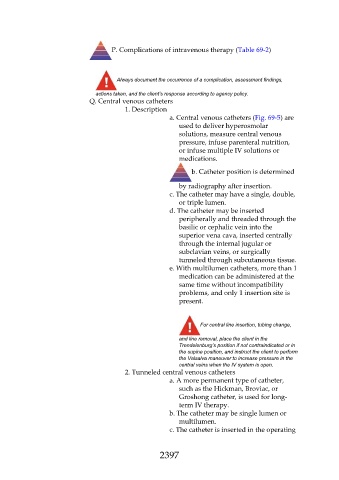Page 2397 - Saunders Comprehensive Review For NCLEX-RN
P. 2397
P. Complications of intravenous therapy (Table 69-2)
Always document the occurrence of a complication, assessment findings,
actions taken, and the client’s response according to agency policy.
Q. Central venous catheters
1. Description
a. Central venous catheters (Fig. 69-5) are
used to deliver hyperosmolar
solutions, measure central venous
pressure, infuse parenteral nutrition,
or infuse multiple IV solutions or
medications.
b. Catheter position is determined
by radiography after insertion.
c. The catheter may have a single, double,
or triple lumen.
d. The catheter may be inserted
peripherally and threaded through the
basilic or cephalic vein into the
superior vena cava, inserted centrally
through the internal jugular or
subclavian veins, or surgically
tunneled through subcutaneous tissue.
e. With multilumen catheters, more than 1
medication can be administered at the
same time without incompatibility
problems, and only 1 insertion site is
present.
For central line insertion, tubing change,
and line removal, place the client in the
Trendelenburg’s position if not contraindicated or in
the supine position, and instruct the client to perform
the Valsalva maneuver to increase pressure in the
central veins when the IV system is open.
2. Tunneled central venous catheters
a. A more permanent type of catheter,
such as the Hickman, Broviac, or
Groshong catheter, is used for long-
term IV therapy.
b. The catheter may be single lumen or
multilumen.
c. The catheter is inserted in the operating
2397

